François Cointeraux: the Architect of the ‘Agricultural Proletariat’
François Cointeraux was born in Lyon in 1740 and was introduced to agriculture and construction at an early age through his family’s business ventures. When his uncle designated him the ‘universal heir’ of his company, Cointeraux inherited several buildings in Lyon and around 24 houses in the area. His marriage to Gabrielle Bret in 1765 brought him a substantial dowry, which enabled him to establish himself as a building contractor, and then as an architect in 1770. For the next 15 years, he settled and was active around Lyon, Loyasse, and Vaise, where, in addition to architecture, he practised several trades including farmer, building estimator, expert surveyor, master mason, and, contractor. During this period, he constructed numerous houses in the suburbs and on green-field sites.[1]
From around 1780 to 1785, his social, ideological, and stylistic commitment started to take shape. The trigger was a competition in 1784 run by the Academy of Amiens, on the initiative of Duke Béthune-Charost, that offered a reward for ‘the simplest and least expensive way to prevent and avoid fires in the countryside’.[2] Cointeraux wrote his first dissertation and won the competition. This marked a turning point in his career, after which he turned his attention to the possibilities of ‘pisé’ (rammed earth) as a construction technique and to teaching the agricultural working class how to construct their own cost-effective, fire-resistant, and ‘dignified’ dwellings, founding several educational institutions.[3] Over the course of his life, he produced over 72 pamphlets, essays and lectures on the topic.[4]
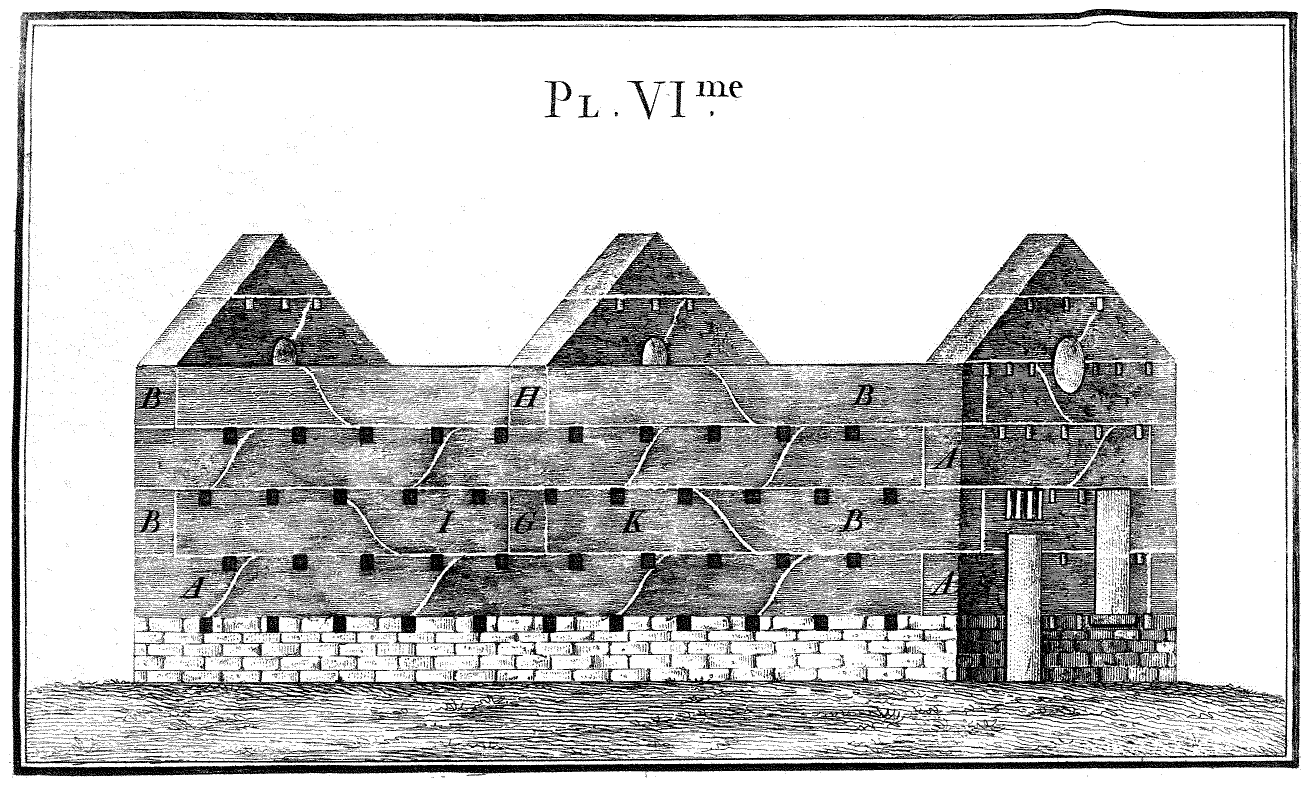

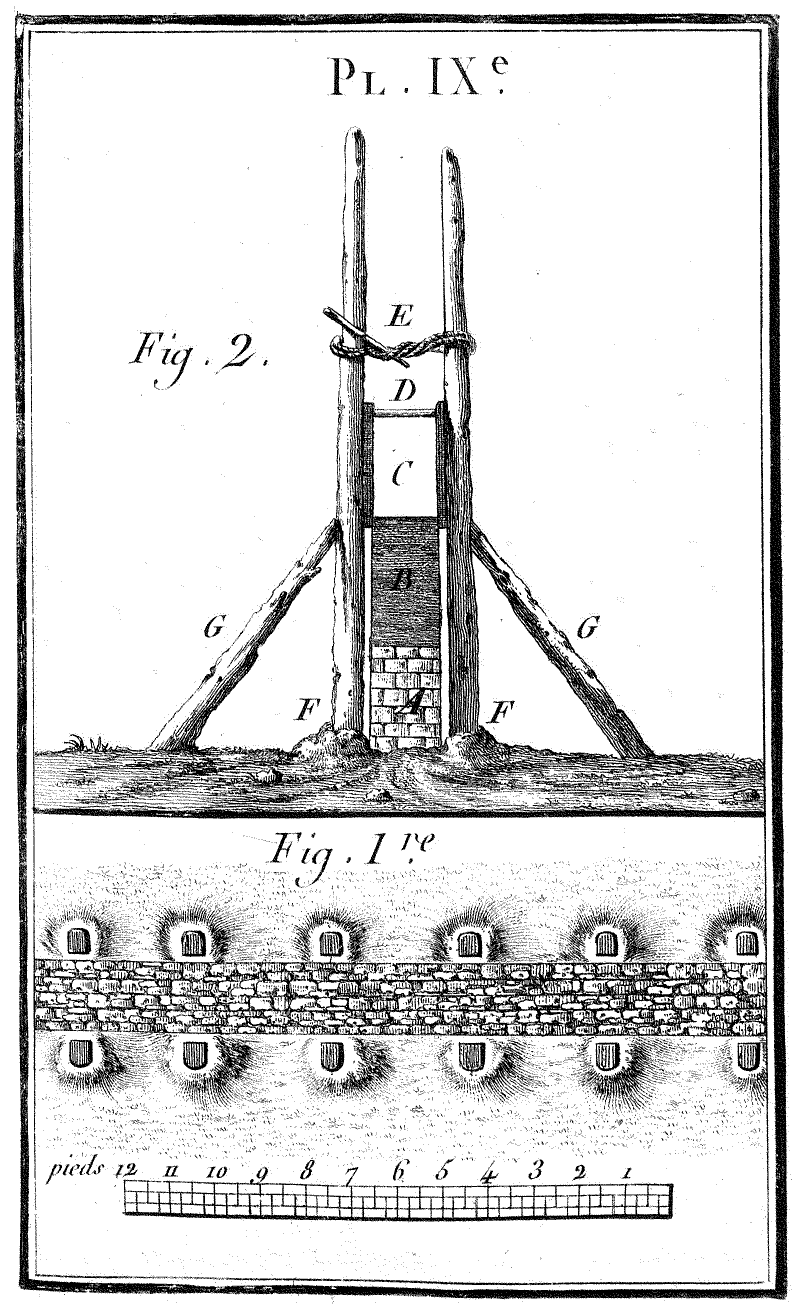
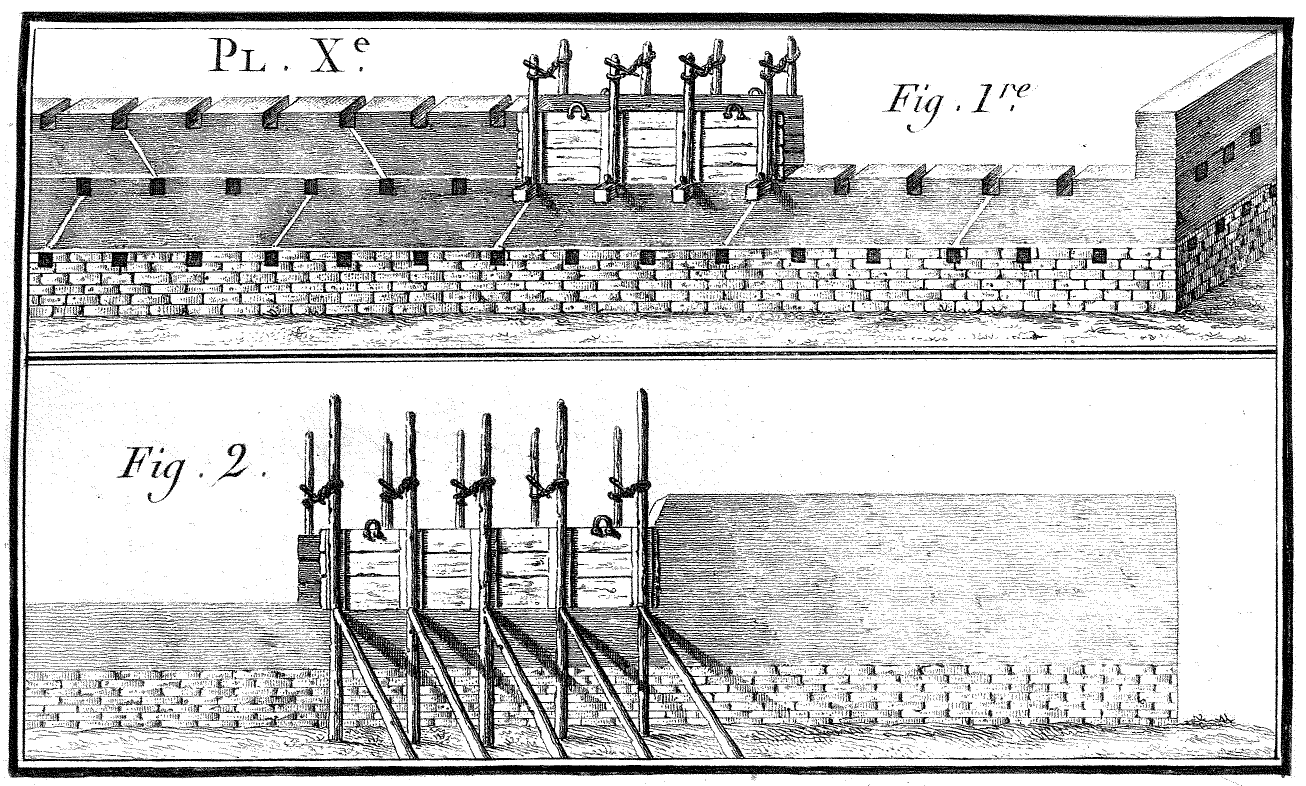
Following the establishment of his first School of Rural Architecture in Grenoble in 1785, Cointeraux moved to the capital to further his experiments. With the protection of the King, he founded a second school on waste ground on the Champs-Elysées offered to him by the Count of Artois. In 1789, however, he lost this support, the protection of the Count, and his land to the French Revolution.[5]
Throughout the Revolution, Cointeraux continued developing his theoretical and practical approaches, unifying architecture and agriculture with his new school of ‘Agritecture’. In addition to the pisé technique, the broad curriculum also covered cultivating fields, building methods for strong houses and stables, technical skills in masonry, woodworking, brick making, painting, and ornamentation, handling clay and tiles as well as acquiring knowledge of the environment, including water, wind, stars, soil, and the cycle of seasons.[6] Ultimately, each of his inventions and experimentations were part of this convergence of agriculture and architecture.[7]
But practical and pragmatic considerations were not his sole driving force: he saw himself in the unique position of representing the ‘agricultural proletariat’ and was motivated by a larger set of beliefs about humankind’s relationship to the land. In his effort to unite architecture and agriculture, he taught his pupils how to transform the earth themselves into food and shelter as a lasting, sustainable source of collective wellbeing[8] And even though he built in different landscapes and engaged in contemporary controversies and projects—notably the Louvre and the Odéon theatre—his focus always rested on the rural world. In a plan he published in 1810 he reiterated his commitment to improving the life of ‘the man of the fields closer to nature’ (‘l’homme des champs plus rapproché de la nature’) seeing that pisé was most fitting for the peasantry most directly reliant on the land.[9]
This idea of an ‘agricultural proletariat’ is particularly interesting in the politically charged context of the French Revolution. Philosopher Jean-Jaques Rousseau’s 1750 work, the first discourse on the Arts and Science, urged to ‘tear down these amphitheatres, smash these marbles!’ The revolutionaries translated Rousseau’s words into action and, in 1792, the National Assembly mirrored this architectural symbolism declaring: ‘war against the manor house, peace to the hut!’ In the struggle for political equality, different building types morphed into political adversaries. The prime example is the Bastille prison—the most despised of the ‘tyrannical châteaux’ in Paris, the Bastille symbolised oppression. Indeed, according to cultural historians Paula Young Lee, the discourse surrounding pisé itself had the power to evoke patriotism. With a focus on durability, economy, and rural housing, earth was a material of ‘political innocence’, untouched by the decadence inherent buildings like mansions and palaces. In the Revolution’s ideological framework, therefore, rammed earth offered a remarkable metaphor for the immense political pressures: as politics threatened to tear apart the land, pisé rammed the soil back together, becoming the very foundation of social structure meant to endure for centuries. On a symbolic level the creation of rammed earth houses ideally embodied reconstruction of the country.[10]
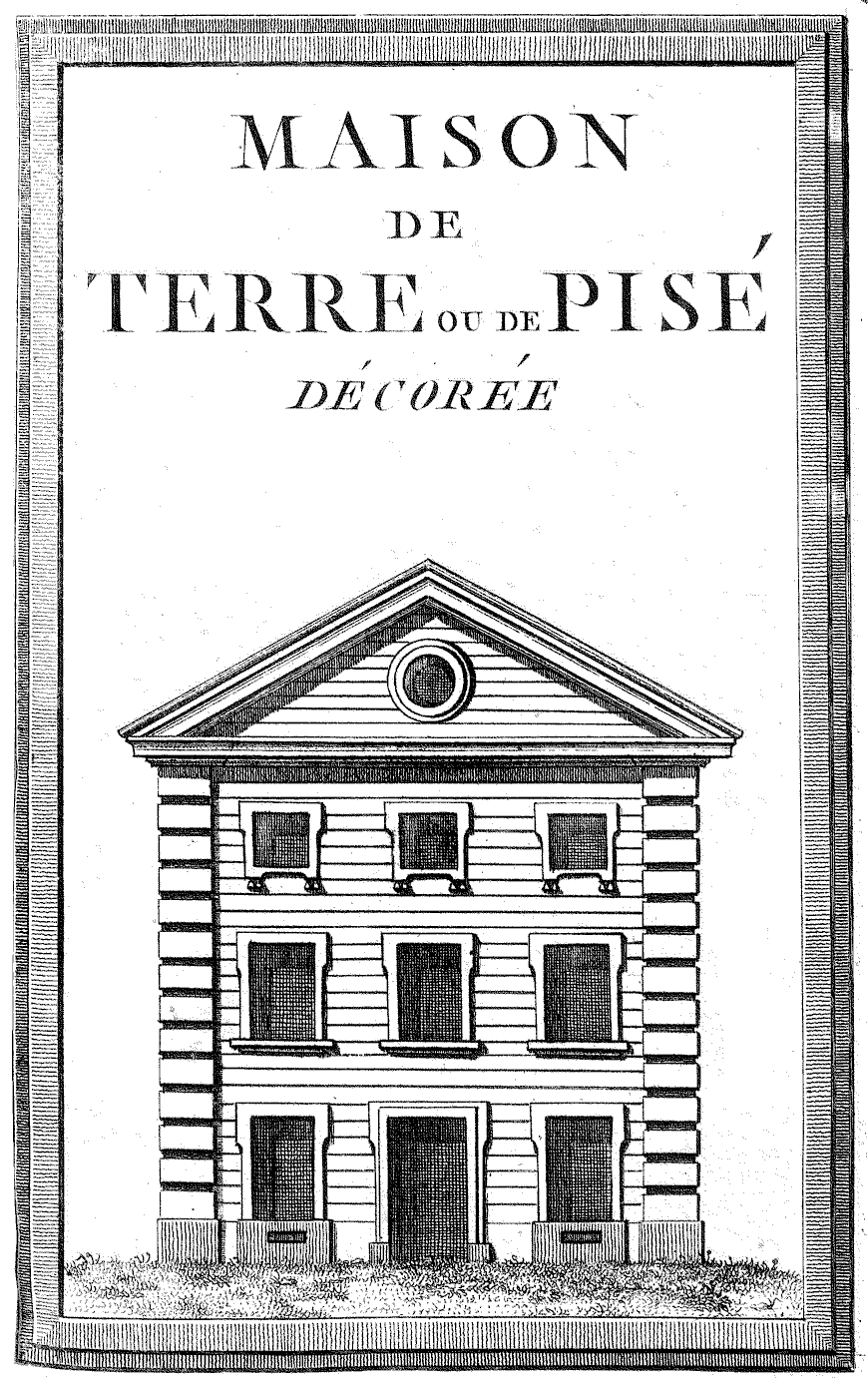
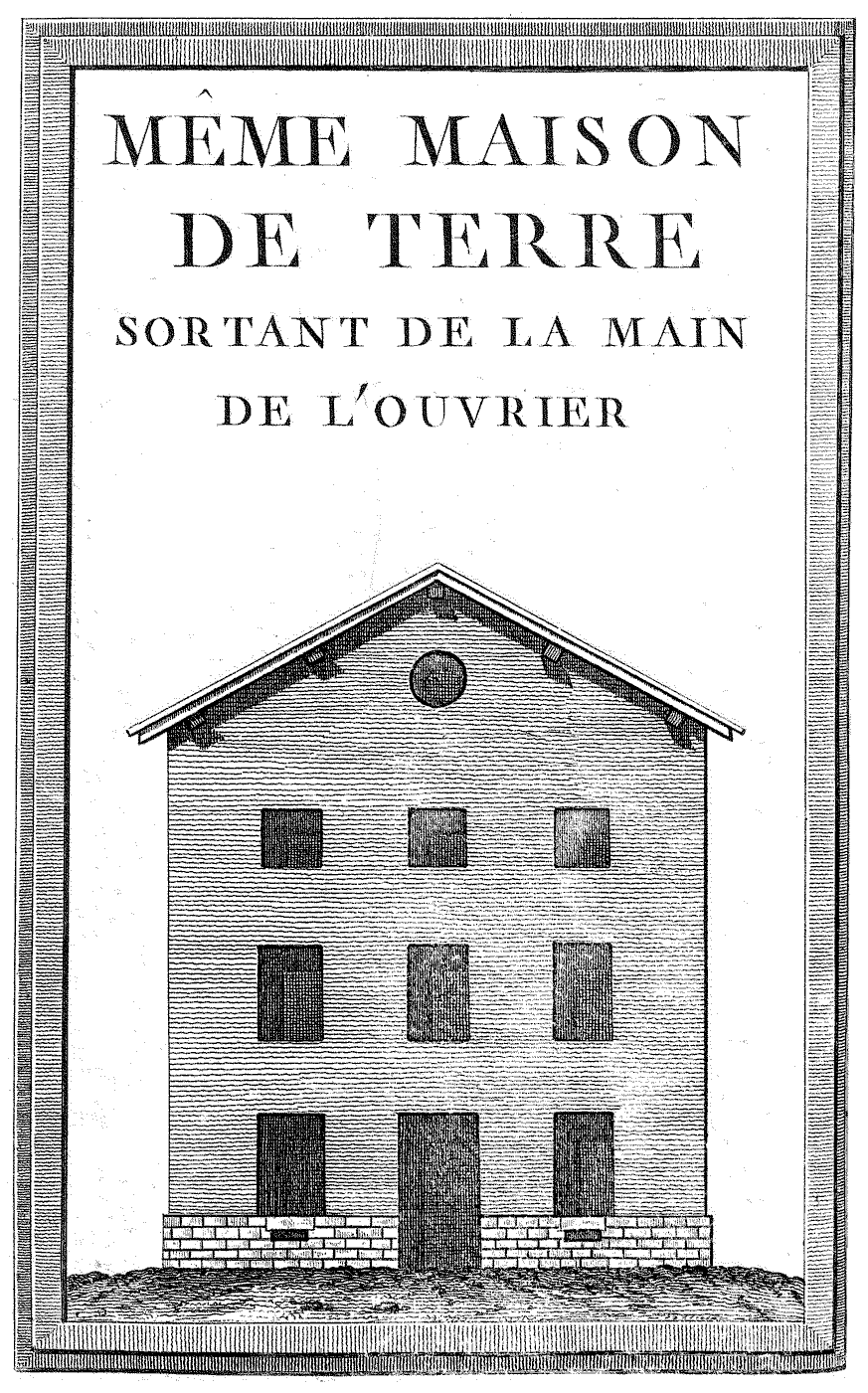
It was at around this time, in 1793, that the National Assembly awarded Cointeraux a considerable sum of money to reward his inventions. Given this support, Cointeraux had ample justification to think that pisé and politics had converged, that earth would be the material of reconstruction, and that his ‘agritecture’ was the future.[11] A letter recently acquired by Drawing Matter addressed to the National Assembly by Cointeraux in 1790 shows, however, that the story was not straightforward:
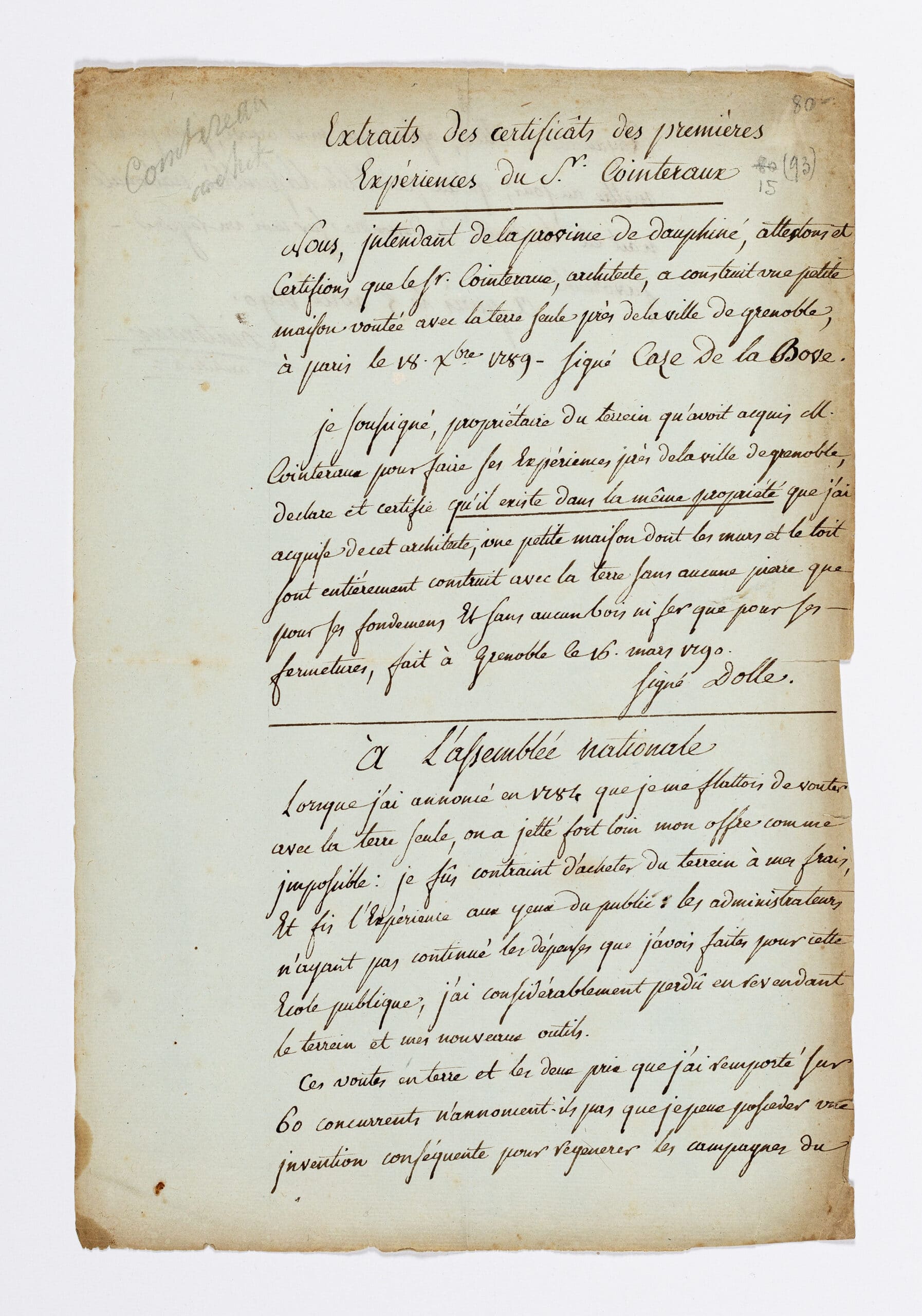
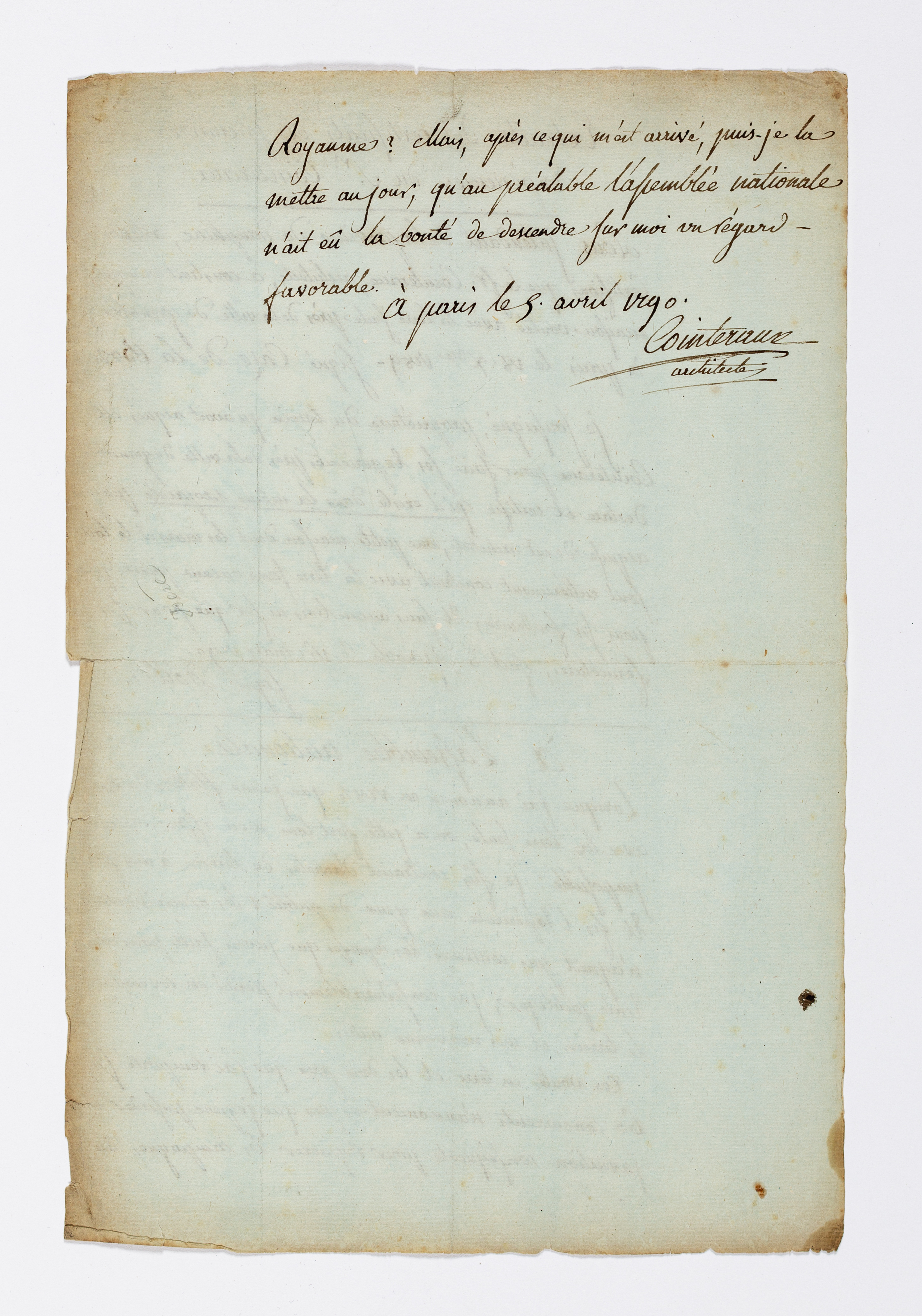
‘We, the Intendant of the province of Dauphine, do testify and certify that the Seigneur Cointeraux, architect, has constructed a small, vaulted house, near to the town of Grenoble, employing solely earth to do so.’
Paris, October 18, 1789 – Signed: Caze De la Bove
‘I, the undersigned, proprietor of the land situated near to the town of Grenoble and acquired by Monsieur Cointeraux for the purpose of conducting his experiments, do declare and certify that there exists, within the same property that I myself then acquired from the architect, a small house whose walls and roof are built entirely of earth, using no stone whatsoever other than that of the foundations and without wood or iron whatsoever, other than that of the closures.’
Grenoble, Match 16, 1790 – Signed Dolle
To the National Assembly
When in 1784 I announced with some pride that I now was able to construct vaults using only earth, my offer was judged as impossible and strongly rejected; in consequence, I was obliged to purchase land at my own expense and to conduct my experiment in the public eye. The administrators did not continue to fund the costs I incurred in constructing the public school and I subsequently lost a considerable sum in reselling the land and my new tools.
Do not these earthen vaults and the two prizes awarded to me from more than sixty contestants, proclaim that I am able to proceed an invention consistent with the regeneration of the Kingdom’s countryside? Yet—after what I have experienced—may I let it be known that at the outset, the National Assembly did not have the goodness to descend a favourable glance in my direction.
Paris, April 5th, 1790 – Cointeraux, Architect
Even though there were initial encouragements, the government was hesitant to fully adopt Cointeraux’s approach. This highlights the tensions within the agenda that recognises housing requirements but rejects rammed earth as a standard construction material for any segment of French society. Ultimately, the political needs and romanticising language of the metropolitan elite may have departed from Cointeraux’s ideas that were centred around the practical issues of the agricultural worker. Removed from any pretence of social power, Cointeraux’s work was not about abstract symbolism or aesthetic ideals. Rather, he built for a specific purpose; agricultural production and the needs of the rural poor were at the heart of his building practice.[12] ‘The dominant passion of the Architect Cointeraux has always been to build cheaply’ wrote an anonymous reviewer of Cointeraux’s winning submission for the Amiens competition in 1787. While the reviewer may have seen this moderation commendable, the expression ‘to build cheaply’ highlights broader implications of class and authority ingrained in construction methods that Cointeraux faced throughout his life. The Emperor Napoléon himself is reported to have criticised Cointeraux’s work and described it as a ‘city of mud’ blaming him for having wasted the means that were available. Napoléon’s rise to power also reflected an ideological shift away from promoting agriculture and toward military conquest. Thus, in 1806 Cointeraux was approached by Emmanuel Crétet, the General Director of Bridges and Roads, who wanted to use the pisé technique for constructing military barracks in Napoléonville hoping to harness the strength, accessibility, and cost-effectiveness of rammed earth as the martial programme required practicability and efficiency.[13] This evidently contradicted Cointeraux’s vision of reconciling humanity and nature as well as his idealism centred around agrarian values.
When he died in Paris in 1830, he seemed to have faded into obscurity—but the ideas he promoted with passion, conviction, and determination in a climate of permanent struggle punctuated by successes, joys, and disappointments, remain immortalised in his writings. Even though the method he championed failed to translate from utopian dreams into widespread action, his dedication to sustainable building, social equality, and innovation remains inspiring over 200 years later.
Anja Segmüller was one of Drawing Matter’s interns this summer. She is studying BA History at the University of Oxford. Cointeraux’s letter was translated for Drawing Matter by Jane Yeoman.
Notes
- In one of his many pamphlets, he declared that ‘I have built in the suburbs and fields more than forty buildings’, (‘j’ai construit dans les faubourges et dans les champs plus de quarante bâtiments’). In Hubert Guillaud, ‘Les carnets de l’architecture de terre. Une grande figure du patrimoine régional Rhône-Alpes: François Cointeraux (1740 – 1830), pioneer de la construction moderne en pisé’, CRATerre-EAG, Monograph No. 3, December 1997, p. 9.
- ‘Le moyen le plus simple et le moins dispendieux de prévenis et éviter les incendies dans les campagnes’, ibid., pp. 10 – 11.
- Paula Lee, ‘Pisé and the Peasantry: François Cointeraux and the Rhetoric of Rural Housing in Revolutionary Paris’, Journal of the Society of Architectural Historians, 2008, Vol.60(1), p. 59.
- Guillaud, ‘Les carnets de l’architecture de terre’, p. 11.
- Ibid.
- Paula Lee, ‘François Cointeraux and the School of “Agritecture” in Eighteenth-Century France’, Journal of Architectural Education, 2013, Vol.60(4), pp. 39 – 40.
- Cointeraux wrote: ‘Architecture has always been treated in isolation; Agriculture, in any period, has been explored separately. This is a mistake; these two practices cannot be deepened except by founding their principles in the same spiritual crucible; from this results a new science, which I duly name Agritecture.’ (‘L’Architecture, de tous les temps, a été traitée isolément ; L’Agriculture, de tous les temps, a été expliquée séparément. C’est une erreur ; ces deux arts ne sauraient être approfondis, qu’en fondant leurs principes dans le même creuset de l’esprit ; il en résulte une science nouvelle, que je nomme avec fondement Agritecture’). In Jean-Philippe Garric, Laurent Baridon, Gilbert Richaud, Les Leçons de la Terre: François Cointeraux (1740-1830) professeur d’architecture rural (INHA, 2016), p. 11.
- Lee, ‘François Cointeraux and the School of “Agritecture” in Eighteenth-Century France’, p. 40.
- Garric, Baridon, Richaud, Les Leçons de la Terre: François Cointeraux (1740-1830) professeur d’architecture rural, p. 9.
- Paula Lee, ‘Pisé and the Peasantry: François Cointeraux and the Rhetoric of Rural Housing in Revolutionary Paris’, pp. 64 – 70.
- Ibid., p. 64.
- Ibid., p. 61.
- Paula Lee, ‘François Cointeraux and the School of “Agritecture” in Eighteenth-Century France’, Journal of Architectural Education, 2013, Vol.60(4), pp. 44 – 5.
